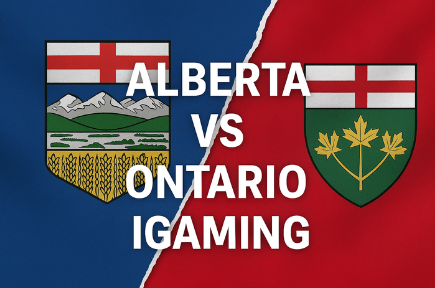
Plans are well underway for Alberta to launch iGaming in early 2026, making it the second province in the country to open a regulated online casino market. Given the success Ontario’s online casino market, it’s reasonable to wonder if Alberta’s operators will flourish in the same way.
Ontario’s dynamic market has experienced year-over-year growth, resulting in gross gaming revenue of $3.2 billion by March of 2025, according to iGaming Ontario’s recent reports. Adjusted for population, is Alberta ready for this same kind of success?
A lot has already happened since the passing of Bill 48, better known as the iGaming Alberta Act, in May 2025. Legislators have been moving swiftly as they anticipate opening their doors to multiple licensed operators. In fact, the most recent development is the formation of the Alberta iGaming Corporation, which is responsible for setting standards, ensuring safe and more responsible gaming rules, along with managing the operator registry.
An effect of this is that operators can expect updates on subjects like licensing requirements, tax rates, and launch dates soon. Minister of Service Alberta and Red Tape Reduction, Dale Nally, mentioned at the Canadian Gaming Summit last month that there are no further developments as of yet regarding Alberta’s new iGaming Market as they are still participating in consultations.
“There’s lots of you today that want me to tell you about our advertising, about our tax rate, about things like that,” Nally said. “We haven’t answered those questions yet. So in terms of next steps, we’re participating in consultations.”
Ontario Models a Roadmap for Other Canadian Provinces
Ontario is the model for other provinces since legalizing its commercial online casino market in April 2022. As proof of its profitability and success, the market records upward of one billion dollars in monthly wagers.
But its success is not just due to the multiple licensed operators, which range from big sportsbook brands to boutique casinos. It also stems from its robust regulatory framework that balances consumer protection with innovation. Provinces watching from the sidelines, including Alberta, have taken note of Ontario’s phased licensing, geolocation checks, and central self-exclusion registry, all of which helped build player confidence without stifling competition.
Beyond the raw betting volume, Ontario’s model delivered big public sector benefits. For instance, transparent reporting allows for timely adjustments to tax and fee structures, while robust anti-money laundering measures and responsible gaming tools set a high bar for player safety. As Alberta prepares to launch in early 2026, the plan is to build on these proven mechanisms, and smoothing out the kinks Ontario encountered in its first year.
Ontario’s Early Stumbles Alberta Should Avoid
Conversely, behind Ontario’s fast success lies some hard-earned lessons. The most glaring, of course, being the launch-day confusion that led to fractured market continuity. Operators already serving Ontario players in the ‘grey’ market were forced to halt play and register under the new iGaming Act. Come launch day, many players were unsure of which operators were licensed while others were stranded with stalled account verification.
Compounding the confusion, strict AGCO compliance forced some operators to rebuild or heavily modify their platforms on the fly. The result? Delayed go‑lives, buggy geolocation and payment flows, and stripped‑down product offerings compared to their global sites.
Over at the regulatory front, AGCO and iGaming Ontario were still refining its processes and rules, particularly around affiliate marketing and responsible gaming. For instance, when AGCO banned affiliates from inducing/promoting gambling using bonuses and language like top casino, operators had to overhaul their entire marketing strategies quickly, risking sanctions, or choosing to exit the market entirely.
The same for its responsible gaming measures. Some Ontario players revert back to less regulated offshore sites than navigate through the new safeguards.
Based on these stumbles, Alberta would do well not to copy-and-paste everything from its eastern neighbor. Ontario online casinos serve a population of over 16 million but Alberta’s iGaming market will launch to approximately 4.8 million residents, under a flat personal-income tax and a distinct corporate-tax structure. That means licensing fees, revenue-sharing formulas, and deposit limits must be calibrated for a smaller market with different fiscal and demographic realities.
By customizing its framework to fit its unique tax regime, geography, and population, Alberta can avoid Ontario’s early turbulence and build a more sustainable and potentially profitable iGaming ecosystem from day one.





